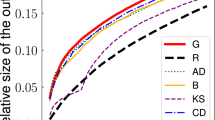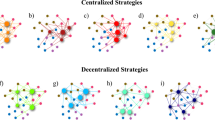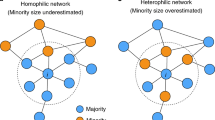Abstract
Social influence maximization models aim to identify the smallest number of influential individuals (seed nodes) that can maximize the diffusion of information or behaviours through a social network. However, while empirical experimental evidence has shown that network assortativity and the joint distribution of influence and susceptibility are important mechanisms shaping social influence, most current influence maximization models do not incorporate these features. Here, we specify a class of empirically motivated influence models and study their implications for influence maximization in six synthetic and six real social networks of varying sizes and structures. We find that ignoring assortativity and the joint distribution of influence and susceptibility leads traditional models to underestimate influence propagation by 21.7% on average, for a fixed seed set size. The traditional models and the empirical types that we specify here also identify substantially different seed sets, with only 19.8% overlap between them. The optimal seeds chosen under empirical influence models are relatively less well-connected and less central nodes, and they have more cohesive, embedded ties with their contacts. Hence, empirically motivated influence models have the potential to identify more realistic sets of key influencers in a social network and inform intervention designs that disseminate information or change attitudes and behaviours.
This is a preview of subscription content, access via your institution
Access options
Access Nature and 54 other Nature Portfolio journals
Get Nature+, our best-value online-access subscription
$29.99 / 30 days
cancel any time
Subscribe to this journal
Receive 12 digital issues and online access to articles
$119.00 per year
only $9.92 per issue
Buy this article
- Purchase on Springer Link
- Instant access to full article PDF
Prices may be subject to local taxes which are calculated during checkout




Similar content being viewed by others

Change history
02 August 2018
In the version of this Letter originally published, in the key for Fig. 1 the red square was mistakenly labelled ‘Low influence’ and ‘High susceptibility’ but should have been labelled ‘High influence’ and ‘Low susceptibility’. This has now been corrected.
References
Kitsak, M. et al. Identification of influential spreaders in complex networks. Nat. Phys. 6, 888–893 (2010).
Banerjee, A., Chandrasekhar, A., Duflo, E. & Jackson, M. The diffusion of microfinance. Science 341, 1236498 (2013).
Kempe, D., Kleinberg, J. & Tardos, É. Maximizing the spread of influence through a social network. In Proc. 9th ACM SIGKDD International Conference on Knowledge Discovery and Data Mining 137–146 (2003).
Kempe, D., Kleinberg, J. & Tardos, É. Maximizing the spread of influence through a social network. Theory Comput. 11, 105–147 (2015).
Centola, D. & Macy, M. Complex contagions and the weakness of long ties. Am. J. Sociol. 113, 702–734 (2007).
Bakshy, E., Rosenn, I., Marlow, C. & Adamic, L. The role of social networks in information diffusion. In Proc. 21st International Conference on World Wide Web 519–528 (2012).
Centola, D., Eguiluz, V. & Macy, M. Cascade dynamics of complex propagation. Physica A 374, 449–456 (2007).
Christakis, N. & Fowler, J. The spread of obesity in a large social network over 32 years. New Engl. J. Med. 357, 370–379 (2007).
Domingos, P. & Richardson, M. Mining the network value of customers. In Proc. 7th ACM SIGKDD International Conference on Knowledge Discovery and Data Mining 57–66 (2001).
van den Bulte, C. & Joshi, Y. New product diffusion with influentials and imitators. Mark. Sci. 26, 400–421 (2007).
Altarelli, F. et al. Containing epidemic outbreaks by message-passing techniques. Phys. Rev. X 4, 021024 (2014).
Newman, M. Spread of epidemic disease on networks. Phys. Rev. E 66, 016128 (2002).
Chen, Y. et al. Finding a better immunization strategy. Phys. Rev. Lett. 101, 058701 (2008).
Kawachi, I. & Berkman, L. Social ties and mental health. J. Urban Health 78, 458–467 (2001).
van Leeuwen, J. Handbook of Theoretical Computer Science, Vol. A: Algorithms and Complexity (MIT Press, Cambridge, MA, 1991).
Chen, W., Wang, Y. & Yang, S. Efficient influence maximization in social networks. In Proc. 15th ACM SIGKDD International Conference on Knowledge Discovery and Data Mining 199–208 (2009).
Wang, C., Chen, W. & Wang, Y. Scalable influence maximization for independent cascade model in large-scale social networks. Data Min. Knowl. Discov. 25, 545–576 (2012).
Borges, C., Brautbar, M., Chayes, J. & Lucier, B. Maximizing social influence in nearly optimal time. In Proc. 25th Annual ACM-SIAM Symposium on Discrete Algorithms 946–957 (2014).
Leskovec, J. et al. Cost-effective outbreak detection in networks. In Proc. 13th ACM SIGKDD International Conference on Knowledge Discovery and Data Mining 420–429 (2007).
Goyal, A., Lu, W. & Laksmanan, L. Celf++: optimizing the greedy algorithm for influence maximization in social networks. In Proc. 20th International Conference Companion on World Wide Web 47–48 (2011).
Tang, Y., Xiaokui, X. & Shi, Y. Influence maximization: near-optimal time complexity meets practical efficiency. In Proc. 2014 ACM SIGMOD International Conference on Management of Data 75–86 (2014).
He, X. & Kempe, D. Robust influence maximization. In Proc. 22nd ACM SIGKDD International Conference on Knowledge Discovery and Data Mining 885–894 (2016).
Chen, W., Lin, T., Tan, Z., Zhao, M. & Zhou, X. Robust influence maximization. In Proc. 22nd ACM SIGKDD International Conference on Knowledge Discovery and Data Mining 795–804 (2016).
Granovetter, M. Threshold models of collective behavior. Am. J. Sociol. 83, 1420–1443 (1978).
Goldenberg, J., Libai, B. & Muller, E. Talk of the network: a complex systems look at the underlying process of word-of-mouth. Mark. Lett. 12, 211–223 (2001).
Goldenberg, J., Libai, B. & Muller, E. Using complex systems analysis to advance marketing theory development: modeling heterogeneity effects on new product growth through stochastic cellular automata. Acad. Mark. Sci. Rev. 9, 1–18 (2001).
Gomez-Rodriguez, M. et al. Influence estimation and maximization in continuous-time diffusion networks. ACM Trans. Inf. Syst. 34, 9 (2016).
Morone, F. & Makse, H. A. Influence maximization in complex networks through optimal percolation. Nature 524, 65–68 (2015).
Newman, M. Assortative mixing in networks. Phys. Rev. Lett. 89, 208701 (2002).
Aral, S., Muchnik, L. & Sundararajan, A. Engineering social contagions: optimal network seeding in the presence of homophily. Netw. Sci. 1, 125–153 (2013).
Bramoullé, Y., Djebbari, H. & Fortin, B. Identification of peer effects through social networks. J. Econ. 150, 41–55 (2009).
Golub, B. & Jackson, M. O. How homophily affects the speed of learning and best-response dynamics. Q. J. Econ. 127, 1287–1338 (2012).
Aral, S., Muchnik, L. & Sundararajan, A. Distinguishing influence-based contagion from homophily-driven diffusion in dynamic networks. Proc. Natl Acad. Sci. USA 106, 21544–21549 (2009).
Aral, S. & Walker, D. Identifying influential and susceptible members of social networks. Science 337, 337–341 (2012).
Bakshy, E., Hofman, J., Mason, W. & Watts, D. Everyone's an influencer: quantifying influence on twitter. In Proc. 4th ACM International Conference on Web Search and Data Mining 65–74 (2011).
Burt, R. Structural holes and good ideas. Am. J. Sociol. 110, 349–399 (2004).
Aral, S. Commentary-identifying social influence: a comment on opinion leadership and social contagion in new product diffusion. Mark. Sci. 30, 217–223 (2011).
Aral, S. & Walker, D. Creating social contagion through viral product design: a randomized trial of peer influence in networks. Manage. Sci. 57, 1623–1639 (2011).
Muchnik, L., Aral, S. & Taylor, S. J. Social influence bias: a randomized experiment. Science 341, 647–651 (2013).
Bakshy, E., Eckles, D. & Bernstein, M. Designing and deploying online field experiments. In Proc. 23rd International Conference on World Wide Web 283–292 (2014).
Aral, S. & Walker, D. Tie strength, embeddedness, and social influence: a large-scale networked experiment. Manage. Sci. 60, 1352–1370 (2014).
Ugander, J. & Backstrom, L. Balanced label propagation for partitioning massive graphs. In Proc. 6th ACM International Conference on Web Search and Data Mining 507–516 (2013).
Pfeiffer, J. III et al. Attributed graph models: modeling network structure with correlated attributes. In Proc. 23rd International Conference on World Wide Web 831–842 (2014).
Acknowledgements
We thank to D. Eckles for invaluable discussions. S.A. acknowledges funding and support from the NSF (Career Award 0953832). The funders had no role in study design, data collection and analysis, decision to publish or preparation of the manuscript.
Author information
Authors and Affiliations
Contributions
S.A. and P.S.D. contributed equally to all parts of the research and writing.
Corresponding authors
Ethics declarations
Competing interests
The authors declare no competing interests.
Additional information
Publisher’s note: Springer Nature remains neutral with regard to jurisdictional claims in published maps and institutional affiliations.
Supplementary information
Supplementary Information
Supplementary Methods, Supplementary Note 1, Supplementary Figures 1–58
Rights and permissions
About this article
Cite this article
Aral, S., Dhillon, P.S. Social influence maximization under empirical influence models. Nat Hum Behav 2, 375–382 (2018). https://doi.org/10.1038/s41562-018-0346-z
Received:
Accepted:
Published:
Issue Date:
DOI: https://doi.org/10.1038/s41562-018-0346-z
This article is cited by
-
Stopping fake news: Who should be banned?
International Journal of Data Science and Analytics (2024)
-
Online influence maximization under continuous independent cascade model with node-edge-level feedback
Knowledge and Information Systems (2024)
-
Friend circles network: formation and the law of news dissemination
Applied Intelligence (2022)
-
Finding early adopters of innovation in social networks
Social Network Analysis and Mining (2022)
-
An influence maximization algorithm based on low-dimensional representation learning
Applied Intelligence (2022)


